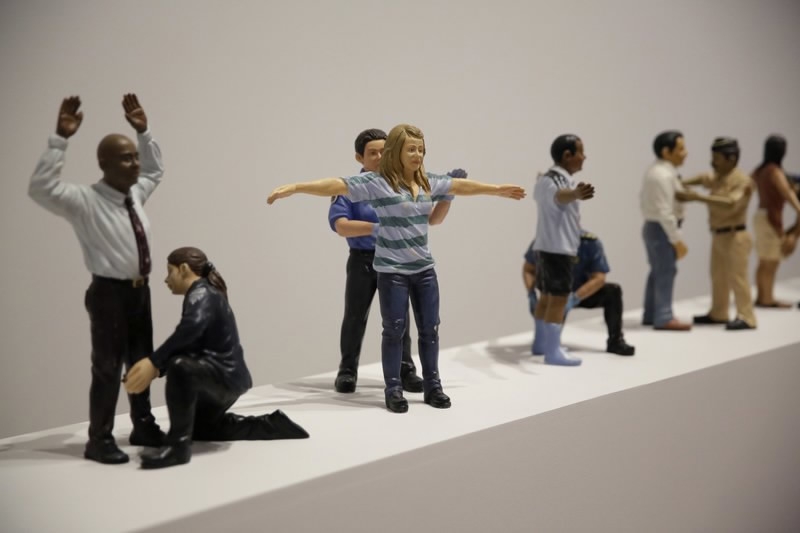
Culture
08:26, 26-Oct-2017
London exhibition 'Age of Terror' explores art since 9/11
CGTN

An exhibition about art since 9/11 is underway in London on Thursday, with images both familiar and shocking of the devastated Twin Towers in New York.
The Imperial War Museum's "Age of Terror" show goes on to display works from the United States, Britain, Afghanistan, Iraq, Syria and beyond, all dealing with September 11, 2001, and its consequences.
Rebecca Newell, the museum's head of art, said Wednesday that 9/11 was "a watershed in our society, our political and cultural identity. And I think you could probably say that it's a watershed for artists."
"That was really the nucleus for where this show and this project started," curator Sanna Moore said at a preview of the exhibition. "As a consequence of the internet, artists are really rapidly informed now, as we all are. I think that feeds in to the subjects they cover."
September 11 coincided with the birth of the internet age, and technology helped make the airliner attacks, which killed some 3,000 people, instantly a worldwide catastrophe.

A staff member looking at German visual artist Hans-Peter Feldmann's installation "9/12 Frontpage" during the media preview for the "Age of Terror: Art since 9/11" exhibition at the Imperial War Museum in London, Wednesday, Oct. 25, 2017. /AP Photo
A staff member looking at German visual artist Hans-Peter Feldmann's installation "9/12 Frontpage" during the media preview for the "Age of Terror: Art since 9/11" exhibition at the Imperial War Museum in London, Wednesday, Oct. 25, 2017. /AP Photo
The exhibition begins with a reminder of how global it was: a room lined with newspaper front pages from September 12, 2001, bearing images of destruction and headlines of war in many languages.
The museum has gathered works by more than 40 artists for the biggest art show in its 100-year history. Some of the pieces pack a visceral punch: "Nein! Eleven?" by British brothers Jake and Dinos Chapman consists of twin mounds of tiny plastic bodies. Others are allusive. Chilean artist Ivan Navarro's "The Twin Towers" appears to be two inverted skyscrapers plunging through the floor into infinity; in fact it's an optical illusion created with mirrors and fluorescent lights.
Other works reflect on the growth of state control and surveillance during the "war on terror" launched by the US after 9/11. Indian artist Jitish Kallat has sculpted a playful line of miniature people being searched, as if in an airport security queue.

Part of Indian artist Jitish Kallat's "Circadian Rhyme 1" displayed during the media preview for the "Age of Terror: Art since 9/11" exhibition at the Imperial War Museum in London, October 25, 2017. /AP Photo
Part of Indian artist Jitish Kallat's "Circadian Rhyme 1" displayed during the media preview for the "Age of Terror: Art since 9/11" exhibition at the Imperial War Museum in London, October 25, 2017. /AP Photo
Some artists work with images that have become uneasily iconic: Britain's Rachel Howard paints a hooded inmate at Iraq's Abu Ghraib prison, where American troops were accused of torturing detainees. Another Briton, John Keane, depicts an orange jumpsuit like those worn by Guantanamo Bay detainees – and by victims of Islamic State group beheadings.
Another section of the show is devoted to weapons – especially the rise of drones, used to kill for the first time by the US in Afghanistan weeks after 9/11 and now an integral, ethically contested part of warfare. Visitors entering the museum step over James Bridle's "Drone Shadow," an outline of a drone drawn on the floor. On one wall, Jim Ricks' "Carpet Bombing" weaves an image of a Predator drone into an Afghan rug.
A final group of works, under the label Home, includes pieces by artists from Iraq, Afghanistan and Syria about their conflict-scarred homelands, as well as works about American and British soldiers returning from war.
"Age of Terror: Art Since 9/11" runs to May 28, 2018.
8150km
Source(s): AP

SITEMAP
Copyright © 2018 CGTN. Beijing ICP prepared NO.16065310-3
Copyright © 2018 CGTN. Beijing ICP prepared NO.16065310-3